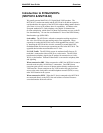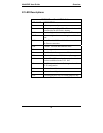
Overview MultiVOIP User Guide
26
Introduction to Analog MultiVOIPs
(MVP130, MVP-210/410/810 & MVP428)
VOIP: The Free Ride. We proudly present Multi-Tech's MVP130, MVP-
210/410/810 generation of MultiVOIP Voice-over-IP Gateways and models
MVP-210G/410G/810G equipped with embedded gatekeeper functionality .
All of these models allow voice/fax communication to be transmitted at no
additional expense over your existing IP network, which has ordinarily been
data only. To access this free voice and fax communication, you simply
connect the MultiVOIP to your telephone equipment and your existing Internet
connection. These analog MultiVOIPs inter-operate readily with T1 or E1
MultiVOIP units.
Capacity. MultiVOIP models MVP810 and MVP810G are eight-channel
units, models MVP410 and MVP410G are four-channel units, and models
MVP210 and MVP210G are two-channel units. The MVP130 is a single-
channel unit. All of these MultiVOIP units have a 10/100Mbps Ethernet
interface and a command port for configuration. The MVP428 is an expansion
circuit card for the four-channel MVP410 that turns it into an eight-channel
voip.
Mounting. Mechanically, the MVP410 and MVP810 MultiVOIPs are
designed for a one-high industry-standard EIA 19-inch rack enclosure. By
contrast, MVP130 and the MVP210 are tabletop units. The product must be
installed by qualified service personnel in a restricted-access area, in
accordance with Articles 110-16, 10-17, and 110-18 of the National Electrical
Code, ANSI/NFPA 70.
Phone System Transparency. These MultiVOIPs inter-operate with a
telephone switch or PBX, acting as a switching device that directs voice and
fax calls over an IP network. The MultiVOIPs have “phonebooks,” directories
that determine to who calls may be made and the sequences that must be used
to complete calls through the MultiVOIP. The phonebooks allow the phone
user to interact with the VOIP system just as they would with an ordinary PBX
or telco switch. When the phonebooks are set, special dialing sequences are
minimized or eliminated altogether. Once the call destination is determined,
the phonebook settings determine whether the destination VOIP unit must strip
off or add dialing digits to make the call appear at its destination to be a local
call.
H. 323, SIP, & SPP. Being H.323 compatible, the analog MultiVOIP unit can
place calls to telephone equipment at remote IP network locations that also
contain H.323 compatible voice-over-IP gateways. It will interface with H.323
software and H.323 gatekeeper units. H.323 specifications also bring to voip
telephony many special features common to conventional telephony. H.323
features of this kind that have been implemented into the MultiVOIP include
Call Hold, Call Waiting, Call Identification, Call Forwarding (from the H.450


















